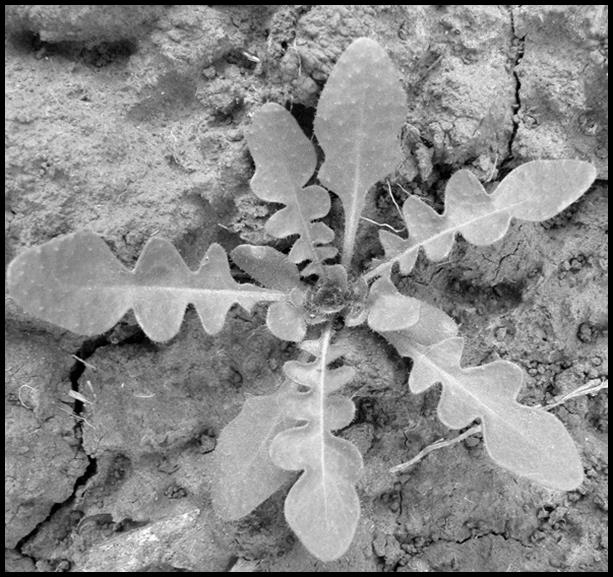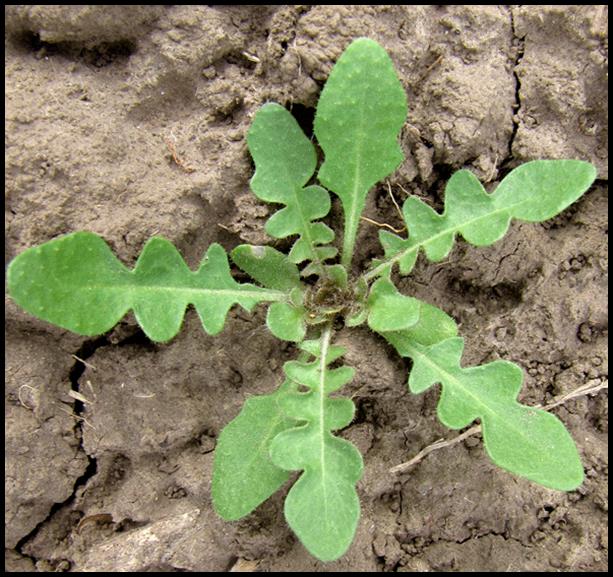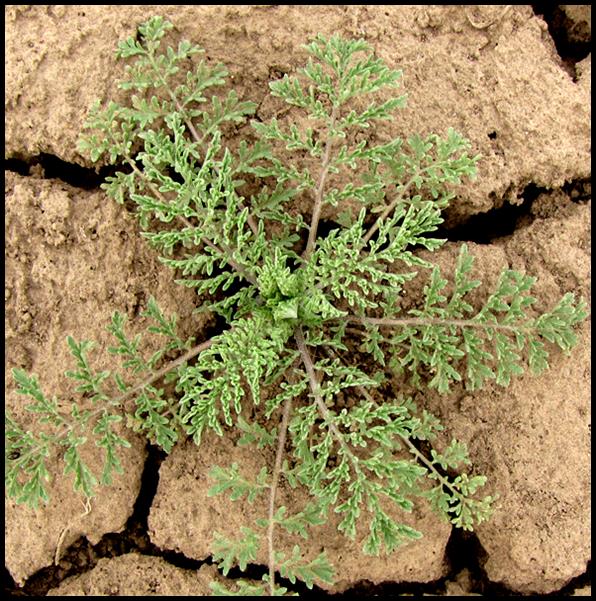Wheat Weed Control
Control of Later Emerging Kochia in Wheat
Mustard Control in Wheat
Be A Good Neighbor: Control Your Volunteer Wheat
Weed Control in Wheat Stubble
Controlling large weeds in wheat pre-harvest
On Wheat - Dicamba, 2,4-D or MCPA?
Control of Later Emerging Kochia in Wheat
Getting kochia under control in any cropping system that includes wheat begins with the wheat crop during the spring, and shortly after wheat harvest. This is not always easy, even if an application of dicamba had been made before jointing to control kochia present at that time.
Later-emerging kochia in wheat
While a majority of kochia emerges early in the spring, some emergence can extend over a period of weeks or months. A herbicide applied early in the spring will need to have residual activity to be effective on later-emerging kochia. Several ALS-inhibitor herbicides have good residual activity, but are ineffective on ALS-resistant kochia. Most kochia are now ALS-resistant.
Dicamba, a non-ALS herbicide and one of the more effective products on most populations of kochia, must be applied before the jointing stage of wheat, meaning that later-emerging plants may not be controlled. With most of the wheat jointed now, the use of dicamba products is likely no longer an option this season.
Most other non-ALS herbicides that can be applied at a later growth stage of wheat are primarily contact herbicides that require thorough coverage to be effective, and this can be difficult to achieve when the wheat canopy gets larger and covers up some of the kochia present. Two exceptions are Huskie and Starane. These two products can be applied at later growth stages of wheat. They are both translocated (Starane more so than Huskie) and are effective on kochia. Huskie should be applied with NIS and ammonium sulfate according to the label.
Control in wheat stubble after harvest
If kochia has not been completely controlled in the wheat crop, then it may be present at the time wheat is harvested. In most cases, the kochia plants will have grown taller than the wheat canopy and will get “topped” by the combine as the wheat is harvested.
If kochia has been topped, producers should wait until some regrowth has occurred before applying herbicides in the wheat stubble to control it. A combination of glyphosate plus either dicamba or Starane may be the most effective treatments to control kochia in wheat stubble. Even if kochia populations are resistant to glyphosate, the tank-mix combinations with dicamba or Starane will probably provide good control, as long as the kochia aren’t too big or stressed. Some 2,4-D can be added to the mixture to help with control of other broadleaf weeds, although 2,4-D generally will not help much in controlling kochia. Clarity or Starane tanked mixed with a pound of atrazine and 2 oz of Sharpen have provided excellent control of kochia following harvest. This is another option depending on future cropping plans.
An additional option would be to treat the kochia with Gramoxone. Gramoxone activity will be increased if applied with atrazine. However, only corn or sorghum may be planted the following spring if atrazine is used. If soybeans will be planted the following spring, metribuzin (Dimetric, Glory, Metri, Metribuzin, Tricor, and others) can be used instead of atrazine to enhance the Gramoxone activity. Wheat can be planted 4 months after a metribuzin application. These chemistries are contact herbicides requiring thorough coverage and more spray volume than does a glyphosate treatment.
To improve the chances of getting good control after wheat harvest, apply the postharvest treatments in the morning hours or after the field has received some moisture, not when the kochia plants are under maximum stress. If kochia has been severely drought stressed before treatment, waiting a couple days following a good rain may provide optimum control from the herbicide treatment. If glyphosate is the product of choice, use the highest labeled rate, and make sure to add ammonium sulfate and any necessary surfactants.
Recent research results
In 2014, a trial at the K-State Southwest Research-Extension Center – Tribune field compared several herbicide products applied at different times for kochia control in an irrigated wheat field. The field was seeded late at the rate of 40 lbs/acre to simulate a relatively thin stand. The only weed present in this field was kochia. The wheat was harvested July 9.
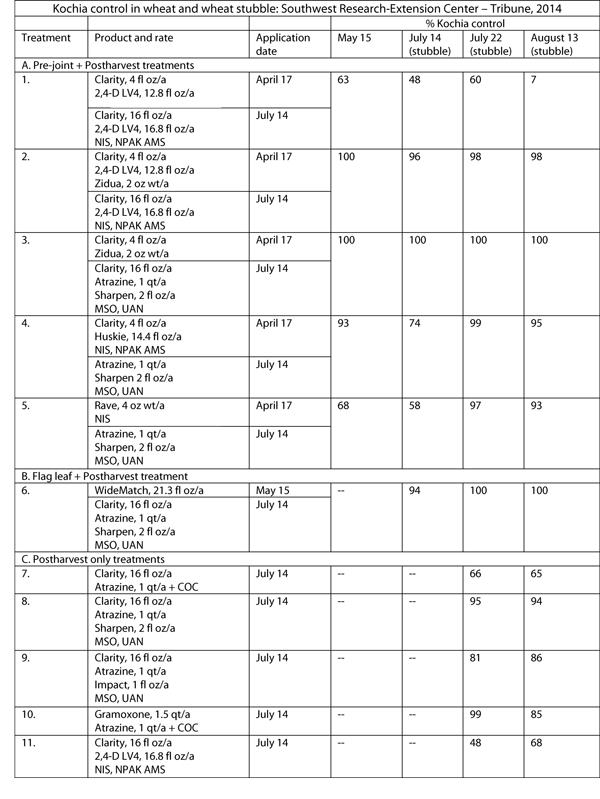
Comments on this trial:
- At the time the pre-joint treatments were applied on April 17, kochia were very small. The largest kochia were about 0.5 inches tall. A significant amount of kochia emerged following this pre-joint treatment. All pre-joint treatments provided excellent control of kochia 9 days following application. A rating 28 days after application on May 25 suggest that kochia were emerging through any dicamba applications, as well as the Clarity+Huskie application. Only those pre-joint treatments that included 2 oz of Zidua provided excellent residual control of kochia. Zidua has limited foliar activity and primarily controls later-germinating seedlings. The kochia that were present following wheat harvest after the pre-joint treatments containing Zidua (treatments 2 and 3) were much smaller and emerged later than kochia in the other pre-joint treatments. However, it is also important to note that Zidua is only labelled up to the 4 tiller stage of wheat, which often occurs prior to mid-April in most wheat fields.
- On May 14, the WideMatch treatment was applied to kochia 0.5 to 1.5 inches tall. WideMatch did a very good job controlling the kochia, indicating that coverage was adequate. Complete control was not attained, however. The postharvest treatment following WideMatch applied at flag leaf did provide complete control of kochia. At the time the postharvest treatments were made, the kochia following the WideMatch treatment made at flag leaf were much smaller than the kochia following the earlier, pre-joint treatments.
- The wheat was harvested July 9. At the time of the postharvest treatments, July 14, kochia was actively growing and protruding above the stubble. Much of the kochia was 15-20 inches tall at that time. Where there was excellent in-crop control, only a few kochia were present and those plants were about 2-6 inches tall.
- The heavy density of kochia in the stubble following the pre-joint Clarity+2,4-D treatment proved to be unmanageable after harvest. The postharvest treatment of Clarity+2,4-D provided 64% control, which would be considered a failure.
- Huskie+Clarity (treatment 4) provided about 75% control of kochia at the end of the season. A postharvest treatment of atrazine and Sharpen provided very good control, with only an occasional plant recovering.
- The incrop treatment with Rave (treatment 5) did not provide adequate control in the wheat crop, likely because the kochia in this trial were ALS-resistant and the dicamba residual control was too short. The postharvest treatment of atrazine+Sharpen did provide very good control, however (as it did following the incrop Huskie treatment).
- A postharvest only approach isn’t recommended. Unfortunately, many producers attempt to manage kochia in this manner, especially when the wheat crop is marginal.
- The best of the postharvest-only treatments was Sharpen+atrazine+Clarity, which was the only treatment to exceed 90% control by August 13. Postharvest-only treatments that provided inadequate control were Clarity+atrazine and Clarity+2,4-D, with less than 70% control.
Dallas Peterson, Weed Management Specialist
Curtis Thompson, Extension Agronomy State Leader and Weed Management Specialist
Mustard Control in Wheat
Mustards are a common broadleaf weed in wheat throughout Kansas. Unfortunately, producers often do not notice these weeds in their fields until they start to bloom in the spring. As a result, producers often don't think about control until that time. Although it is still possible to get some control at that time with herbicides, mustards are much more difficult to control at that stage and often have already reduced wheat yields.
To keep yield losses to a minimum, mustards should be controlled by late winter or very early spring, before the plants begin to bolt, or stems elongate. If winter annual broadleaf weeds are present in the fall, they can be controlled with any number of ALS-inhibiting herbicides, including Ally, Amber, Finesse, Affinity, Rave, Olympus, or PowerFlex. Huskie, 2,4-D, and MCPA can also provide good control of most mustards if the weeds are at the right stage of growth and actively growing, and if the wheat is at the correct growth stage. Dicamba and Starane are not very effective for mustard control.
In the later winter or early spring, blue mustard (Figure 1) is perhaps the most difficult of the winter annual broadleaf weeds to control because it bolts very early. To be effective on blue mustard, herbicides typically need to be applied to blue mustard in late February or early March. Blue mustard is more difficult to control than tansy mustard with 2,4-D because blue mustard has often already bolted by the time 2,4-D can be safely applied to wheat. Thus, 2,4-D often is applied too late to be effective on blue mustard.
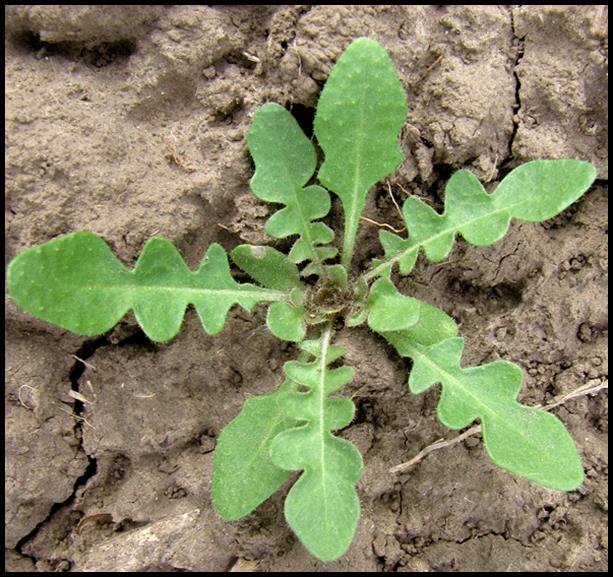
Flixweed and tansy mustard (Figure 2) should be treated when they are no larger than two to three inches across and two to three inches tall. As these plants become larger the control decreases dramatically. Ester formulations of 2,4-D and MCPA are more effective on tansy mustard and flixweed than amine formulations. Wheat should be fully tillered before applying 2,4-D or tillering will be inhibited and wheat yields may be decreased.
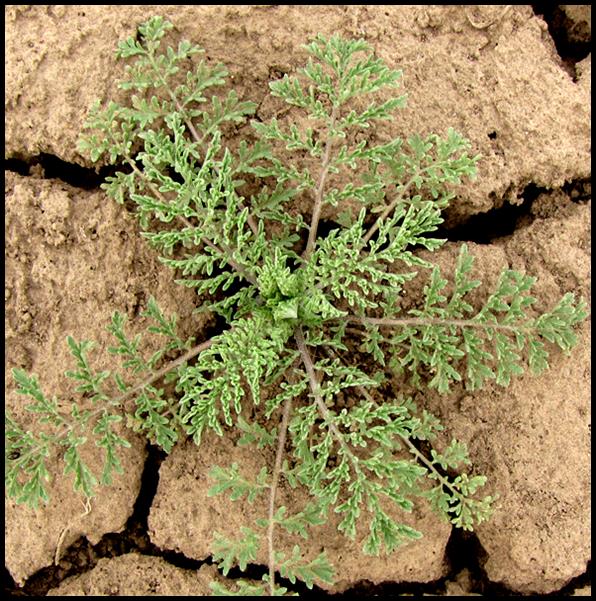
Be A Good Neighbor: Control Your Volunteer Wheat
Have you walked through your wheat stubble lately? Have you looked closely at the fields where you are going to plant wheat this fall? It is especially important this year because of the hail that we received this spring. Even though you are likely not planning to plant those fields to wheat this fall, they might be next to another field that is going to be wheat. It IS worth spending a few minutes now looking because it could help your (or your neighbor's) yields this next harvest!
Every year at about this time, you hear 'Control your volunteer wheat'. The primary reason for this is to decrease the threat of wheat streak mosaic virus infecting newly emerged wheat. Wheat streak mosaic virus can be devastating to a wheat field. This virus is moved by the wheat curl mite. These mites live on volunteer wheat during the summer and rely on it as a food source. They are microscopic and cannot be seen with the naked eye. In addition, the mites are highly mobile and can travel up to ½ mile on wind currents!
It is critical that all volunteer wheat within ½ mile be completely dead at least two weeks prior to planting. Volunteer wheat can be controlled by working the ground or by herbicide application. Grazing volunteer is not an effective option because there is green wheat material left and the mites can be living in that material.
As the summer progresses into fall, these mites are looking for a new food source...and what better than young, tender, juicy wheat plants that have just emerged. The worst case scenario is that the volunteer is dying just as the new wheat is emerging.
Fall infections of wheat streak mosaic are the most devastating to the wheat crop. However, infections can take place from wheat emergence until late spring. The fall infections are the most detrimental to the crop because the plant is young and not completely established.
Think of the wheat streak mosaic virus like the flu virus in humans. It is the toughest on the young because they have a harder time fighting off the virus. In addition, there is no medicine or treatment to cure the virus. Wheat that is stressed will be more susceptible to severe symptoms. This includes stress from drought, lack of nutrients, or poor growing conditions. The only difference is that humans can fight off the virus and wheat cannot fight it off.
So take a few minutes and check for volunteer wheat. It may save your (or your neighbor's) wheat yields this next harvest.
Weed Control in Wheat Stubble
Due to rainfall across our area, weeds are rapidly growing in wheat stubble. It is a good idea to control these weeds now, before they set seed. It is also a good time to control them with the recent rains because they are actively growing and will rapidly take up the herbicides.
Weeds growing now in wheat stubble fields, without crop competition, set ample seed -- which will be likely to cause a problem in following crops. It is especially important to prevent seed production from happening on fields that will be planted to crops with limited options for weed control, such as grain sorghum, sunflower, or annual forages. It is especially difficult to control broadleaf weeds in sunflower and grassy weeds in sorghum that emerge after crop emergence. Preventing weed seed production ahead of these crops is essential. Seed of some weed species can remain viable for several years, so allowing weeds to produce seed can create weed problems for multiple years.
In addition, as we progress to the end of July and early August, the kochia and Russian thistle will begin to flower. This is because they are sensitive to the daylength and the shortening days trigger flowering. It is important to control these weeds before they begin to produce seeds.
If the field will be planted to Roundup Ready corn or soybeans, producers may decide they can just wait and control any weed and grass seed that form now and emerge next season with a postemergence application of glyphosate in the corn or soybeans. However, with the concerns over the development of glyphosate-resistant weeds, kochia, Palmer amaranth, and waterhemp, it would be far better to control these weeds now in wheat stubble. That way, other herbicides with a different mode of action can be tank-mixed with glyphosate to ensure adequate control.
Producers should control weeds in wheat stubble fields by applying the full labeled rate of glyphosate with the proper rate of ammonium sulfate additive. As mentioned, it is also a good idea to add 2,4-D or dicamba (unless there is cotton or other susceptible crops in the area) to the glyphosate. Do not apply the growth regulator herbicides around cotton. Tank mixes of glyphosate and either 2,4-D or dicamba will help control weeds that are difficult to control with glyphosate alone, and will help reduce the chances of developing glyphosate-tolerant weed populations.
Often dicamba or 2,4-D tankmixes with glyphosate may not perform well under the drier conditions of western Kansas, especially on kochia and Russian thistle; however this year with the improved moisture conditions, we may find glyphosate tank mixes will work well. If drought and heat stress set in, however, utilizing Gramoxone with atrazine (atrazine is synergistic with Gramoxone) has been a more effective treatment than glyphosate/dicamba or glyphosate/2,4-D.
Several have asked about the addition of atrazine for residual weed control in fallow. Although atrazine provides residual control of weeds, it is best applied later in the fall. At this time of year, atrazine residual is quite short and will not provide adequate control of fall emerged weeds/winter annuals. An application of atrazine needs to be made in the fall (mid October through November), depending on the weeds being targeted. Also, keep in mind that atrazine antagonizes glyphosate – just the opposite of the synergistic effect of atrazine and Gramoxone. Do not apply atrazine with reduced rates of glyphosate.
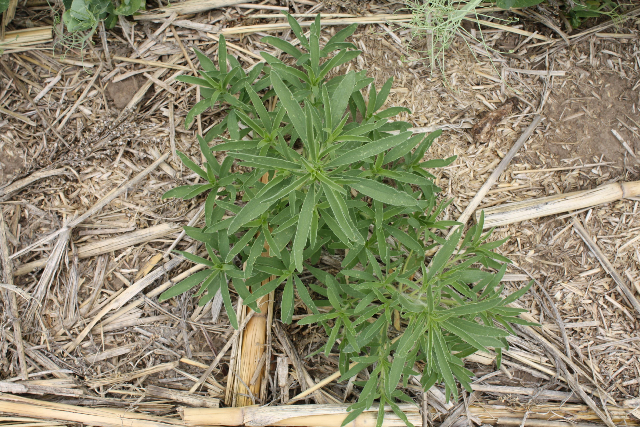
Controlling large weeds in wheat pre-harvest
Late-season weeds in wheat continue to be a problem in many parts of Kansas as a result of the thin wheat crop and continued wet weather. No one wants to spend extra money on a below-average crop, but these weeds can make harvest very difficult. However, there continues to be a lot of questions about which herbicides are approved and and the use guidelines and restrictions for pre-harvest treatments in wheat.
One herbicide that is sometimes mentioned as a pre-harvest treatment is paraquat. Paraquat is not labeled for pre-harvest treatment in wheat. Application of paraquat to wheat is an illegal treatment and can result in a quarantine and destruction of the harvested grain, along with severe fines.
Below are the various herbicide options producers can use as pre-harvest aids in wheat. There are differences in how quickly they act to control the weeds, the interval requirement between application and grain harvest, and the level or length of control achieved. All of them will require good thorough spray coverage to be most effective.
|
Product and rate |
Advantages | Disadvantages | Comments |
| Aim (1 to 2 oz) |
Acts quickly, usually within 3 days. Short waiting interval before harvest – 3 days. |
Controls only broadleaf weeds. Regrowth of weeds may occur after 2-3 weeks or more, depending on the rate used. |
Apply after wheat is mature. Always apply with 1% v/v crop oil concentrate in a minimum spray volume of 5 gal/acre for aerial application and 10 gal/acre for ground applications. Do not apply more than 2 oz of Aim during the growing season. |
| Dicamba (0.5 pt) + 2,4-D (0.5 to 1 qt of 4 lb/gal) | Broad-spectrum broadleaf weed control |
A waiting period of 7 days (dicamba) - 14 days (2,4-D) is required before harvest. Acts slowly to kill the weeds. Controls only broadleaf weeds. |
Apply when the wheat is in the hard dough stage and green color is gone from nodes the stem. Do not allow grazing or use feed from treated area |
| Glyphosate (1 to 2 pt of 3 lb ae/gal) + 2, 4-D (1 to 2 pts) | Provides control of both grasses and susceptible broadleaf weeds. |
Acts slowly. May take up to 2 weeks to completely kill weeds and grasses. Cannot harvest grain until 7 days (glyphosate) to 14 days (2,4-D) after application. |
Apply when wheat is in the hard dough stage (30% or less grain moisture). Consult label for recommended adjuvants. Do not feed treated straw or permit dairy animals or meat animals being finished for slaughter to graze treated fields within 2 weeks after treatment. Not recommended for wheat being harvested for use as seed. |
| Metsulfuron (0.1 oz) + 2,4-D (0.5 to 2 pt of 4 lb/gal) | Provides control of susceptible broadleaf weeds. |
Acts slowly. Cannot harvest grain until 10 days (metsulfuron) to 14 days (2,4-D) after application. Controls only broadleaf weeds. |
Apply when wheat is in the dough stage. Always apply with a nonionic surfactant at 0.25 to 0.5% v/v. Do not use on soils with a pH greater than 7.9. Weeds growing under limited moisture may not be controlled. Do not use treated straw for livestock feed. |
| 2,4-D LVE | Provides control of susceptible broadleaf weeds. |
Acts slowly. Weak on kochia and wild buckwheat. Waiting period is 14 days before harvesting wheat. |
Apply when wheat is in the hard dough stage to control large, actively growing broadleaf weeds. Weeds under drought stress may not be controlled. Do not use treated straw for livestock feed. Consult label of individual products for preharvest interval requirements. |
--Dallas Peterson, K-State Weed Specialist
On Wheat - Dicamba, 2,4-D or MCPA?
When we are topdressing wheat this spring, it is usually a good plan of attack to use a tank-mix containing some type of growth regulator herbicide. So, which one – dicamba, 2,4-D or MCPA – is the best to use? And when can I use them?
In general, the sooner this is done, and the smaller the weeds, the better the results will be. Spring applications generally are most effective on winter annual broadleaf weeds soon after green-up when weeds are still in the rosette stage of growth, and during periods of mild weather. Once weeds begin to bolt and wheat starts to develop more canopy, herbicide performance often decreases dramatically.
When applying herbicides at this time of year, near jointing, there are some timing issues related to the growth stage of wheat that producers will have to take into account.
Dicamba can be applied to wheat between the 2-leaf and jointing stages of wheat. Application of dicamba after wheat reaches the jointing stage of growth causes severe prostrate growth of wheat and significant risk of yield loss. Dicamba is effective for control of kochia, Russian thistle, and wild buckwheat, but is not good for control of mustard species. Kochia, Russian thistle, and wild buckwheat are summer annual weeds that may emerge before or after wheat starts to joint, so timing of dicamba for control of these weeds can sometimes be difficult. Fortunately, dicamba provides some residual control of these weeds following application. Herbicides containing dicamba include Banvel, Clarity, Rave, Pulsar, Agility SG, and several generic dicamba products.
Other herbicides that must be applied prior to jointing include Agility SG, Beyond (on Clearfield varieties only), Olympus, Olympus Flex, Orion, PowerFlex, Pulsar, Rage D-Tech, and Rave.
MCPA and 2,4-D have different application guidelines. In general, MCPA is safer on wheat than 2,4-D, especially when applied prior to tillering. We recommend that 2,4-D not be applied to wheat until it is well-tillered in the spring. Application of 2,4-D prior to tillering hinders the tillering process, causes general stunting and can result in significant yield loss.
2,4-D is labeled for application to wheat from the full-tiller stage until prior to the boot stage of growth, but is probably safest between full-tiller and jointing stages of growth. Wheat will sometimes exhibit prostrate growth from 2,4-D applications applied in the jointing stage of growth, but yields generally are not significantly affected if applied before the boot stage of growth.
MCPA is relatively safe on young wheat and can be applied after the wheat is in the three-leaf stage (may vary by product label) until it reaches the boot stage of growth. Consequently, MCPA would be preferred over 2,4-D if spraying before wheat is well-tillered. Neither herbicide should be applied once the wheat is near or reaches the boot stage of growth, as application at that time can result in malformed heads, sterility, and significant yield loss.
Both 2,4-D and MCPA are available in ester or amine formulations. Ester formulations generally provide a little better weed control than amine formulations at the same application rates, but are more susceptible to vapor drift. Ester formulations generally are compatible for use with fertilizer carriers, while amine formulations often have physical compatibility problems when mixed with liquid fertilizer.
Other herbicides used in the spring on wheat can be applied up to the time the flag leaf is visible, or later. Affinity BroadSpec, Affinity TankMix, Ally Extra SG, Express, Harmony + 2,4-D or MCPA, Harmony Extra, and Supremacy must be applied before the flag leaf is visible. Huskie and WideMatch can be applied through the flag leaf stage. Herbicides that can be applied later in the spring – prior to the boot stage -- include Ally + 2,4-D, Amber, Finesse, Starane Ultra, and Starane Plus Salvo.
